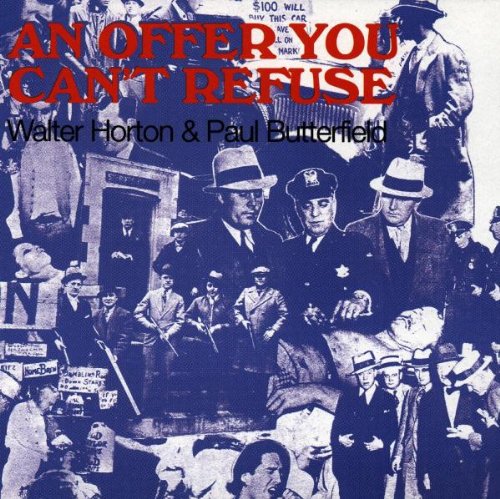
Too often we take our own local artists for granted, and it takes outsiders to keep the memory of their work alive. This is probably true of many great musicians in almost every culture; it's certainly true of American music. \For example, Europeans have a long history of preserving both American Jazz and Blues through literature, and with recordings.
When Swedish sound technician, and Chicago Blues enthusiast Olle Helander makes his journey to the Sutherland Hotel at 4569 Drexel Avenue in Chicago on May 22nd of 1964, he does it as an historian. At the time, he is thinking about the immediate benefit of recording some of the cities blues artists for his employer, but he does not know that he is making an important contribution to the history of a music unique to the U.S..
 So, armed with a Nagra tape recorder, and 4 channel mixer (state of the art technology in 1964), over a period of about a week Helander records a whole roster of little known South Side blues acts on behalf of the Swedish Broadcasting Corporation.
So, armed with a Nagra tape recorder, and 4 channel mixer (state of the art technology in 1964), over a period of about a week Helander records a whole roster of little known South Side blues acts on behalf of the Swedish Broadcasting Corporation.During his visit he records Big Walter Horton, Eddie Boyd, Mike Bloomfield (before he joins the Butterfield band), Sunnyland Slim, Willie Mabon, among others, but the tracks by a 22 year old Paul Butterfield are what interests us in this post. When Helander returns to Sweden, the sets are edited, and then broadcast on Swedish radio under the title of Blueskvarter (At The Bluesquarters) volume 1 and 2. All of these remastered recordings are still available online through Amazon.

Originally, Helander records the set with Butterfield on May 21st, but the Sutherland is under construction causing annoying noise to leak into the recordings, so they reschedule to the 22nd. It should be mentioned here that these tracks are advertised as Butterfield tracks, but they are really recordings of Paul Butterfield as a side man with The Smokey Smothers Blues Band, not the other way around. According to Smothers, while driving down the street one day he happens to hear a young Butterfield playing his harmonica and he asks him to join his band.
Often these tracks are sold under different titles, the most common one being the 1972, Red Lightning release An Offer You Can't Refuse. The liner notes of this official release says the tracks are from the summer of 1963, Big John's, but they are in fact part of the Sutherland Hotel recordings.
These same tracks have been hawked by bootleggers for years under such titles as: Droppin' Out with The Paul Butterfield Blues Band, and include tracks from Newport Folk Festival, July 25th 1965, with some tracks from a tape Bill Graham makes of the band when they play the Fillmore Auditorium in San Francisco. They recordings also show up as Sutherland Hotel Tapes (also a bootleg). Don't be fooled, they all originate from the Helander recordings.
One way you can determine what you are buying is to remember that during the Sutherland Hotel session, these were the tracks captured: Everything's Gonna Be Alright, Poor Boy, Got My Mojo Workin;, Last Night, Loaded, and One room Country Shack, all other purported tracks from this session are from other sources.
 So, are these tracks worth the purchase? As a harmonica player, and devoted fan of Butterfield's style I think these tracks are an important part of any collection. However, when I first bought this set on vinyl as An Offer You Can't Refuse the experience was disappointing. I remember expecting more of the energy I heard on his later material, and thinking, it isn't here.
So, are these tracks worth the purchase? As a harmonica player, and devoted fan of Butterfield's style I think these tracks are an important part of any collection. However, when I first bought this set on vinyl as An Offer You Can't Refuse the experience was disappointing. I remember expecting more of the energy I heard on his later material, and thinking, it isn't here.Of course, the sound quality is victim of the technology of the early sixties, and consequently, doesn't carry as much punch as say the Paul Butterfield Blues Band conveys. The vocal track is a bit muffled and doesn't really showcase Butterfield's skill as a blues singer.
 However, considering Butterfield is only about 22 years old at this time, his playing is amazing! He demonstrates such a strong command of the harmonica, and vocal interpretation!
However, considering Butterfield is only about 22 years old at this time, his playing is amazing! He demonstrates such a strong command of the harmonica, and vocal interpretation! The composers of blues songs are a fairly small group in the early '60's, so, the fact that Butterfield is writing in the genre at twenty-two is significant. Latin rhythms are a trend in the 50s and 60s mainstream pop, so, he is trying to tap into that trend. For these reasons the stand out track in the whole set is Loaded.
In the end, all Butterfield fans owe a lot to the Swedish Broadcasting Corporation for sending Helander to Chicago to record Butterfield, even if he is a sideman at the time.

No comments:
Post a Comment